Target Audience in Microbusiness: Food Wastage of Restaurants in the UK
VerifiedAdded on 2022/12/27
|15
|4731
|2
AI Summary
This dissertation focuses on the significance of targeting audience through market research to reduce food wastage in UK restaurants. It aims to evaluate the changes that can be made by focusing on targeted audiences to minimize food waste costs.
Contribute Materials
Your contribution can guide someone’s learning journey. Share your
documents today.
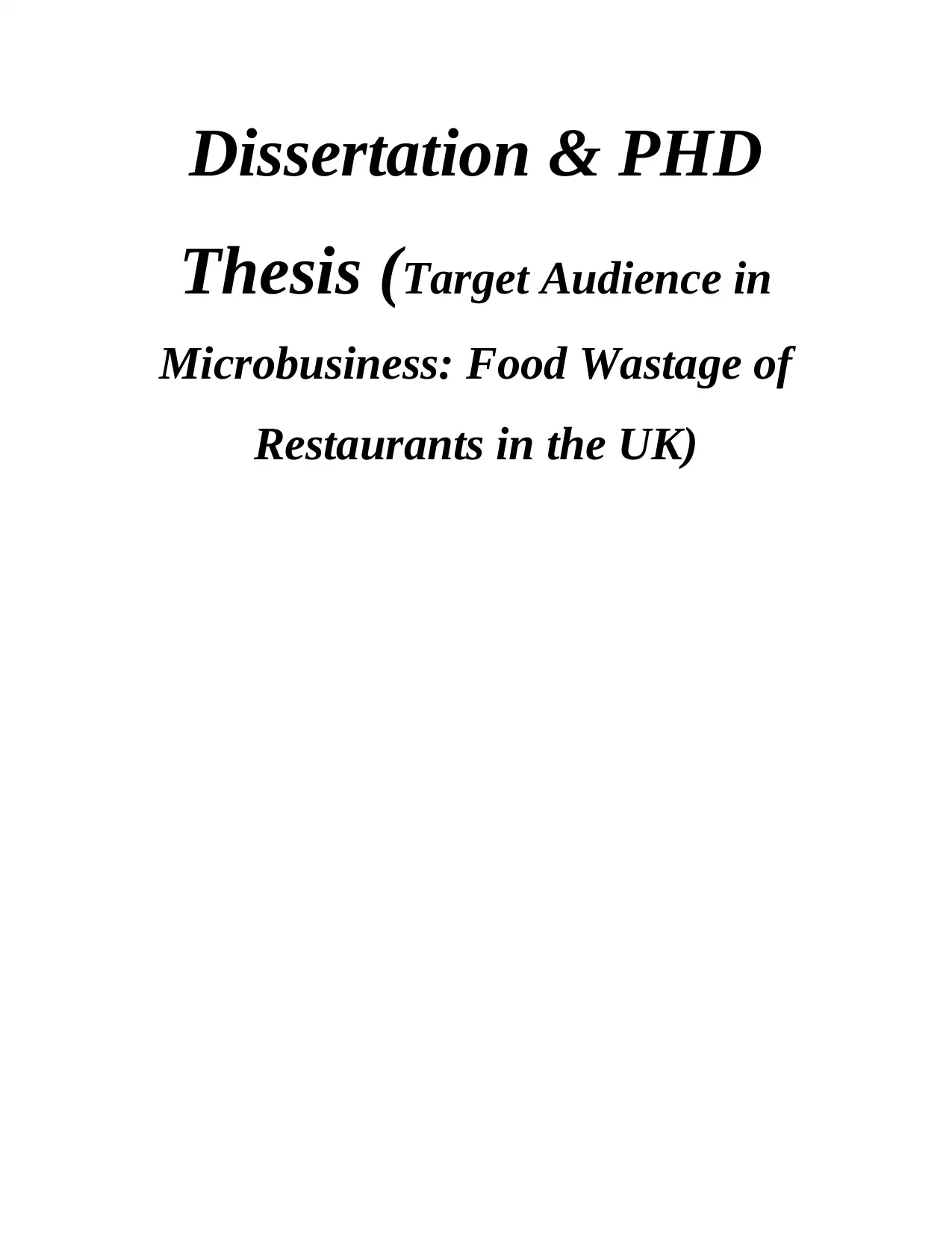
Dissertation & PHD
Thesis (Target Audience in
Microbusiness: Food Wastage of
Restaurants in the UK)
Thesis (Target Audience in
Microbusiness: Food Wastage of
Restaurants in the UK)
Secure Best Marks with AI Grader
Need help grading? Try our AI Grader for instant feedback on your assignments.
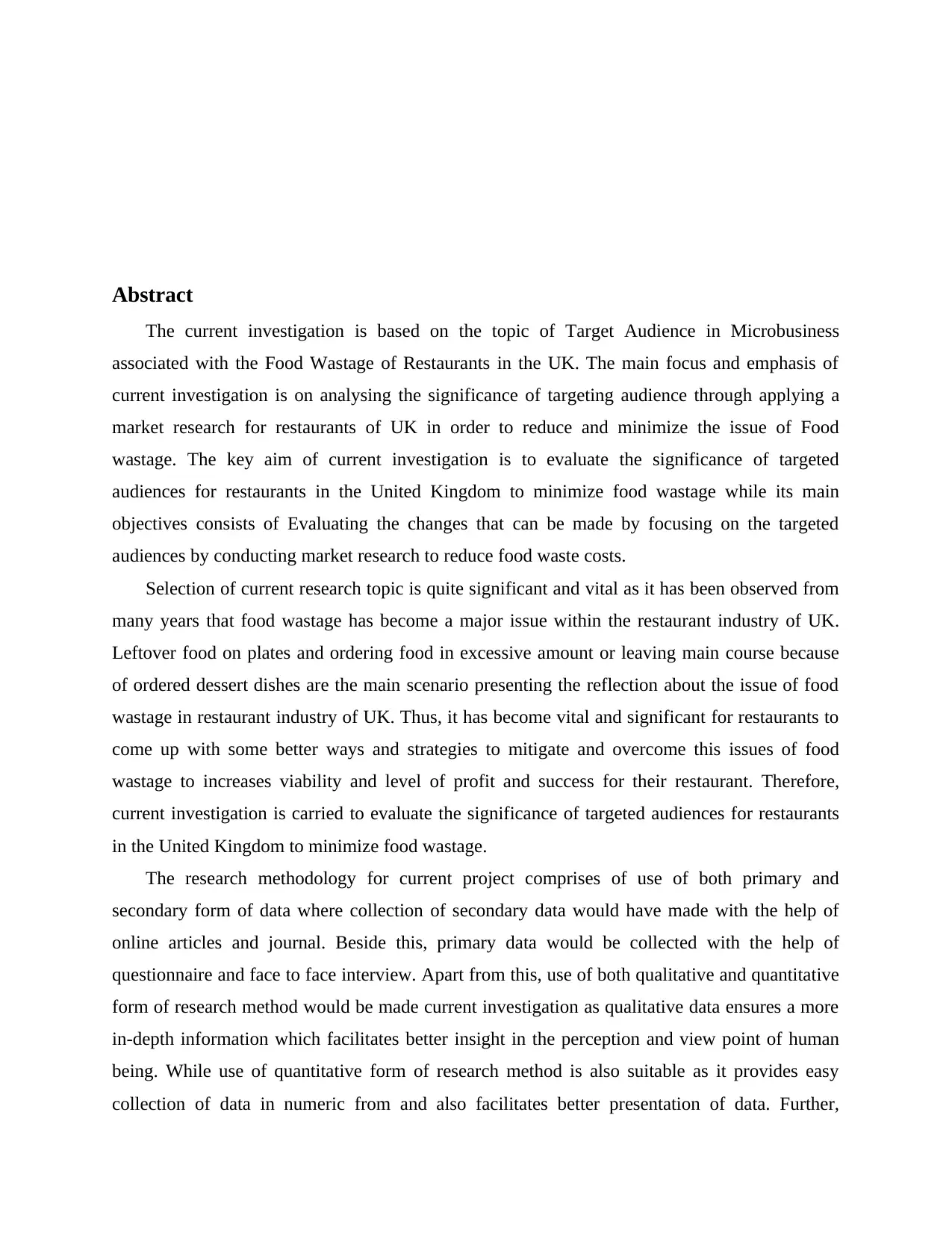
Abstract
The current investigation is based on the topic of Target Audience in Microbusiness
associated with the Food Wastage of Restaurants in the UK. The main focus and emphasis of
current investigation is on analysing the significance of targeting audience through applying a
market research for restaurants of UK in order to reduce and minimize the issue of Food
wastage. The key aim of current investigation is to evaluate the significance of targeted
audiences for restaurants in the United Kingdom to minimize food wastage while its main
objectives consists of Evaluating the changes that can be made by focusing on the targeted
audiences by conducting market research to reduce food waste costs.
Selection of current research topic is quite significant and vital as it has been observed from
many years that food wastage has become a major issue within the restaurant industry of UK.
Leftover food on plates and ordering food in excessive amount or leaving main course because
of ordered dessert dishes are the main scenario presenting the reflection about the issue of food
wastage in restaurant industry of UK. Thus, it has become vital and significant for restaurants to
come up with some better ways and strategies to mitigate and overcome this issues of food
wastage to increases viability and level of profit and success for their restaurant. Therefore,
current investigation is carried to evaluate the significance of targeted audiences for restaurants
in the United Kingdom to minimize food wastage.
The research methodology for current project comprises of use of both primary and
secondary form of data where collection of secondary data would have made with the help of
online articles and journal. Beside this, primary data would be collected with the help of
questionnaire and face to face interview. Apart from this, use of both qualitative and quantitative
form of research method would be made current investigation as qualitative data ensures a more
in-depth information which facilitates better insight in the perception and view point of human
being. While use of quantitative form of research method is also suitable as it provides easy
collection of data in numeric from and also facilitates better presentation of data. Further,
The current investigation is based on the topic of Target Audience in Microbusiness
associated with the Food Wastage of Restaurants in the UK. The main focus and emphasis of
current investigation is on analysing the significance of targeting audience through applying a
market research for restaurants of UK in order to reduce and minimize the issue of Food
wastage. The key aim of current investigation is to evaluate the significance of targeted
audiences for restaurants in the United Kingdom to minimize food wastage while its main
objectives consists of Evaluating the changes that can be made by focusing on the targeted
audiences by conducting market research to reduce food waste costs.
Selection of current research topic is quite significant and vital as it has been observed from
many years that food wastage has become a major issue within the restaurant industry of UK.
Leftover food on plates and ordering food in excessive amount or leaving main course because
of ordered dessert dishes are the main scenario presenting the reflection about the issue of food
wastage in restaurant industry of UK. Thus, it has become vital and significant for restaurants to
come up with some better ways and strategies to mitigate and overcome this issues of food
wastage to increases viability and level of profit and success for their restaurant. Therefore,
current investigation is carried to evaluate the significance of targeted audiences for restaurants
in the United Kingdom to minimize food wastage.
The research methodology for current project comprises of use of both primary and
secondary form of data where collection of secondary data would have made with the help of
online articles and journal. Beside this, primary data would be collected with the help of
questionnaire and face to face interview. Apart from this, use of both qualitative and quantitative
form of research method would be made current investigation as qualitative data ensures a more
in-depth information which facilitates better insight in the perception and view point of human
being. While use of quantitative form of research method is also suitable as it provides easy
collection of data in numeric from and also facilitates better presentation of data. Further,
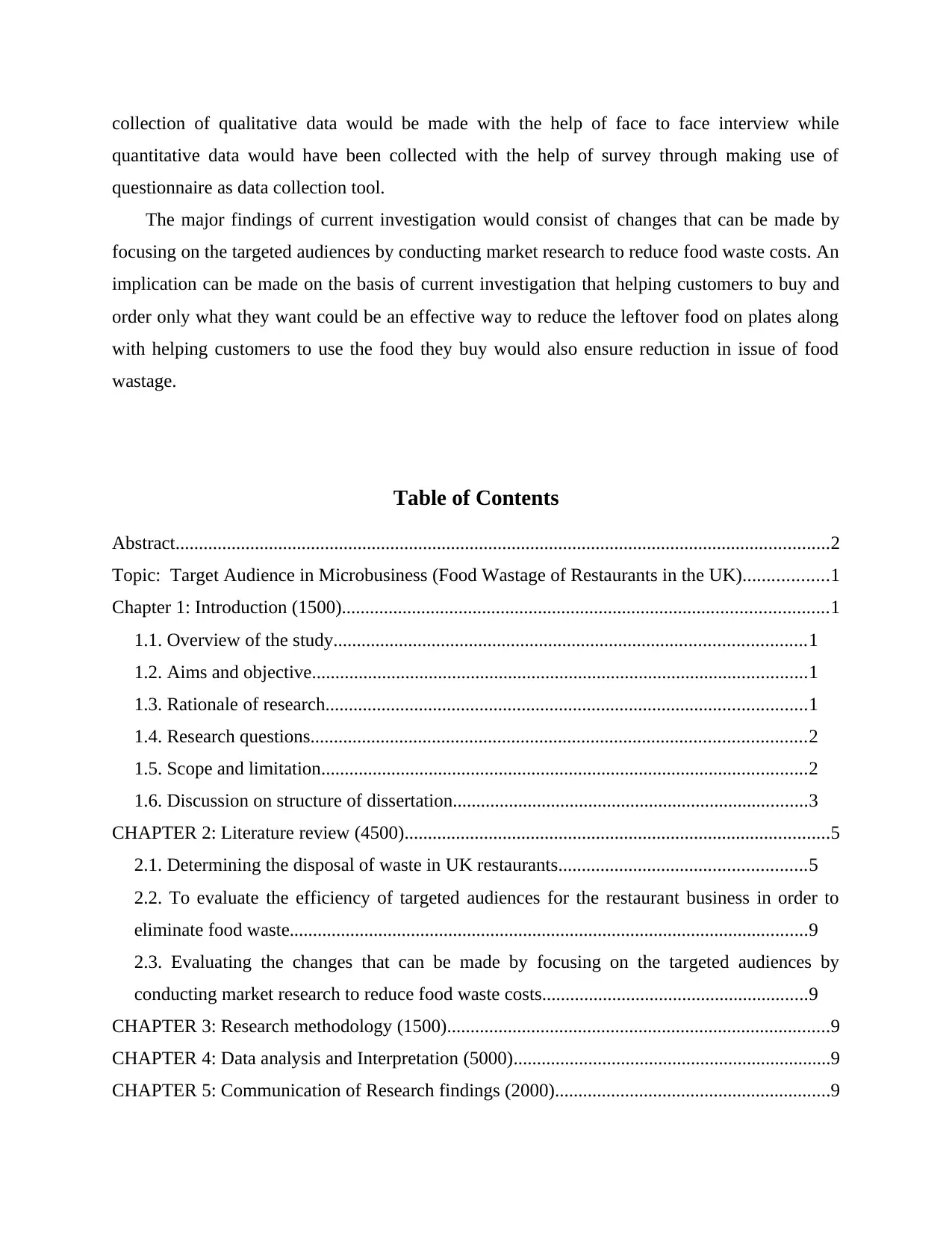
collection of qualitative data would be made with the help of face to face interview while
quantitative data would have been collected with the help of survey through making use of
questionnaire as data collection tool.
The major findings of current investigation would consist of changes that can be made by
focusing on the targeted audiences by conducting market research to reduce food waste costs. An
implication can be made on the basis of current investigation that helping customers to buy and
order only what they want could be an effective way to reduce the leftover food on plates along
with helping customers to use the food they buy would also ensure reduction in issue of food
wastage.
Table of Contents
Abstract............................................................................................................................................2
Topic: Target Audience in Microbusiness (Food Wastage of Restaurants in the UK)..................1
Chapter 1: Introduction (1500)........................................................................................................1
1.1. Overview of the study.....................................................................................................1
1.2. Aims and objective..........................................................................................................1
1.3. Rationale of research.......................................................................................................1
1.4. Research questions..........................................................................................................2
1.5. Scope and limitation........................................................................................................2
1.6. Discussion on structure of dissertation............................................................................3
CHAPTER 2: Literature review (4500)...........................................................................................5
2.1. Determining the disposal of waste in UK restaurants.....................................................5
2.2. To evaluate the efficiency of targeted audiences for the restaurant business in order to
eliminate food waste...............................................................................................................9
2.3. Evaluating the changes that can be made by focusing on the targeted audiences by
conducting market research to reduce food waste costs.........................................................9
CHAPTER 3: Research methodology (1500)..................................................................................9
CHAPTER 4: Data analysis and Interpretation (5000)....................................................................9
CHAPTER 5: Communication of Research findings (2000)...........................................................9
quantitative data would have been collected with the help of survey through making use of
questionnaire as data collection tool.
The major findings of current investigation would consist of changes that can be made by
focusing on the targeted audiences by conducting market research to reduce food waste costs. An
implication can be made on the basis of current investigation that helping customers to buy and
order only what they want could be an effective way to reduce the leftover food on plates along
with helping customers to use the food they buy would also ensure reduction in issue of food
wastage.
Table of Contents
Abstract............................................................................................................................................2
Topic: Target Audience in Microbusiness (Food Wastage of Restaurants in the UK)..................1
Chapter 1: Introduction (1500)........................................................................................................1
1.1. Overview of the study.....................................................................................................1
1.2. Aims and objective..........................................................................................................1
1.3. Rationale of research.......................................................................................................1
1.4. Research questions..........................................................................................................2
1.5. Scope and limitation........................................................................................................2
1.6. Discussion on structure of dissertation............................................................................3
CHAPTER 2: Literature review (4500)...........................................................................................5
2.1. Determining the disposal of waste in UK restaurants.....................................................5
2.2. To evaluate the efficiency of targeted audiences for the restaurant business in order to
eliminate food waste...............................................................................................................9
2.3. Evaluating the changes that can be made by focusing on the targeted audiences by
conducting market research to reduce food waste costs.........................................................9
CHAPTER 3: Research methodology (1500)..................................................................................9
CHAPTER 4: Data analysis and Interpretation (5000)....................................................................9
CHAPTER 5: Communication of Research findings (2000)...........................................................9

CHAPTER 6: Conclusion & recommendation (2000)....................................................................9
CHAPTER 7: Reflection (1000)......................................................................................................9
REFERENCES................................................................................................................................9
CHAPTER 7: Reflection (1000)......................................................................................................9
REFERENCES................................................................................................................................9
Secure Best Marks with AI Grader
Need help grading? Try our AI Grader for instant feedback on your assignments.
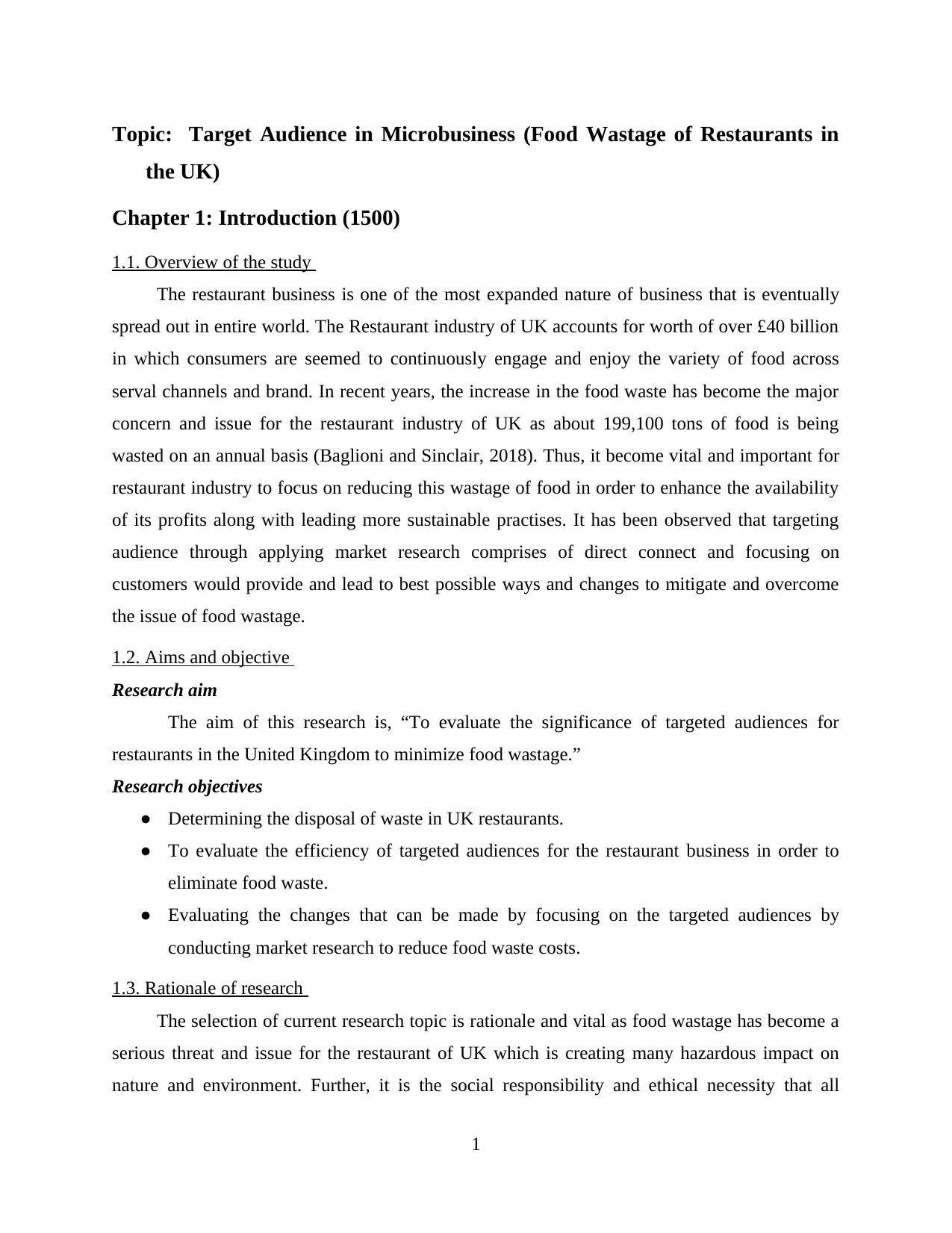
Topic: Target Audience in Microbusiness (Food Wastage of Restaurants in
the UK)
Chapter 1: Introduction (1500)
1.1. Overview of the study
The restaurant business is one of the most expanded nature of business that is eventually
spread out in entire world. The Restaurant industry of UK accounts for worth of over £40 billion
in which consumers are seemed to continuously engage and enjoy the variety of food across
serval channels and brand. In recent years, the increase in the food waste has become the major
concern and issue for the restaurant industry of UK as about 199,100 tons of food is being
wasted on an annual basis (Baglioni and Sinclair, 2018). Thus, it become vital and important for
restaurant industry to focus on reducing this wastage of food in order to enhance the availability
of its profits along with leading more sustainable practises. It has been observed that targeting
audience through applying market research comprises of direct connect and focusing on
customers would provide and lead to best possible ways and changes to mitigate and overcome
the issue of food wastage.
1.2. Aims and objective
Research aim
The aim of this research is, “To evaluate the significance of targeted audiences for
restaurants in the United Kingdom to minimize food wastage.”
Research objectives
● Determining the disposal of waste in UK restaurants.
● To evaluate the efficiency of targeted audiences for the restaurant business in order to
eliminate food waste.
● Evaluating the changes that can be made by focusing on the targeted audiences by
conducting market research to reduce food waste costs.
1.3. Rationale of research
The selection of current research topic is rationale and vital as food wastage has become a
serious threat and issue for the restaurant of UK which is creating many hazardous impact on
nature and environment. Further, it is the social responsibility and ethical necessity that all
1
the UK)
Chapter 1: Introduction (1500)
1.1. Overview of the study
The restaurant business is one of the most expanded nature of business that is eventually
spread out in entire world. The Restaurant industry of UK accounts for worth of over £40 billion
in which consumers are seemed to continuously engage and enjoy the variety of food across
serval channels and brand. In recent years, the increase in the food waste has become the major
concern and issue for the restaurant industry of UK as about 199,100 tons of food is being
wasted on an annual basis (Baglioni and Sinclair, 2018). Thus, it become vital and important for
restaurant industry to focus on reducing this wastage of food in order to enhance the availability
of its profits along with leading more sustainable practises. It has been observed that targeting
audience through applying market research comprises of direct connect and focusing on
customers would provide and lead to best possible ways and changes to mitigate and overcome
the issue of food wastage.
1.2. Aims and objective
Research aim
The aim of this research is, “To evaluate the significance of targeted audiences for
restaurants in the United Kingdom to minimize food wastage.”
Research objectives
● Determining the disposal of waste in UK restaurants.
● To evaluate the efficiency of targeted audiences for the restaurant business in order to
eliminate food waste.
● Evaluating the changes that can be made by focusing on the targeted audiences by
conducting market research to reduce food waste costs.
1.3. Rationale of research
The selection of current research topic is rationale and vital as food wastage has become a
serious threat and issue for the restaurant of UK which is creating many hazardous impact on
nature and environment. Further, it is the social responsibility and ethical necessity that all
1
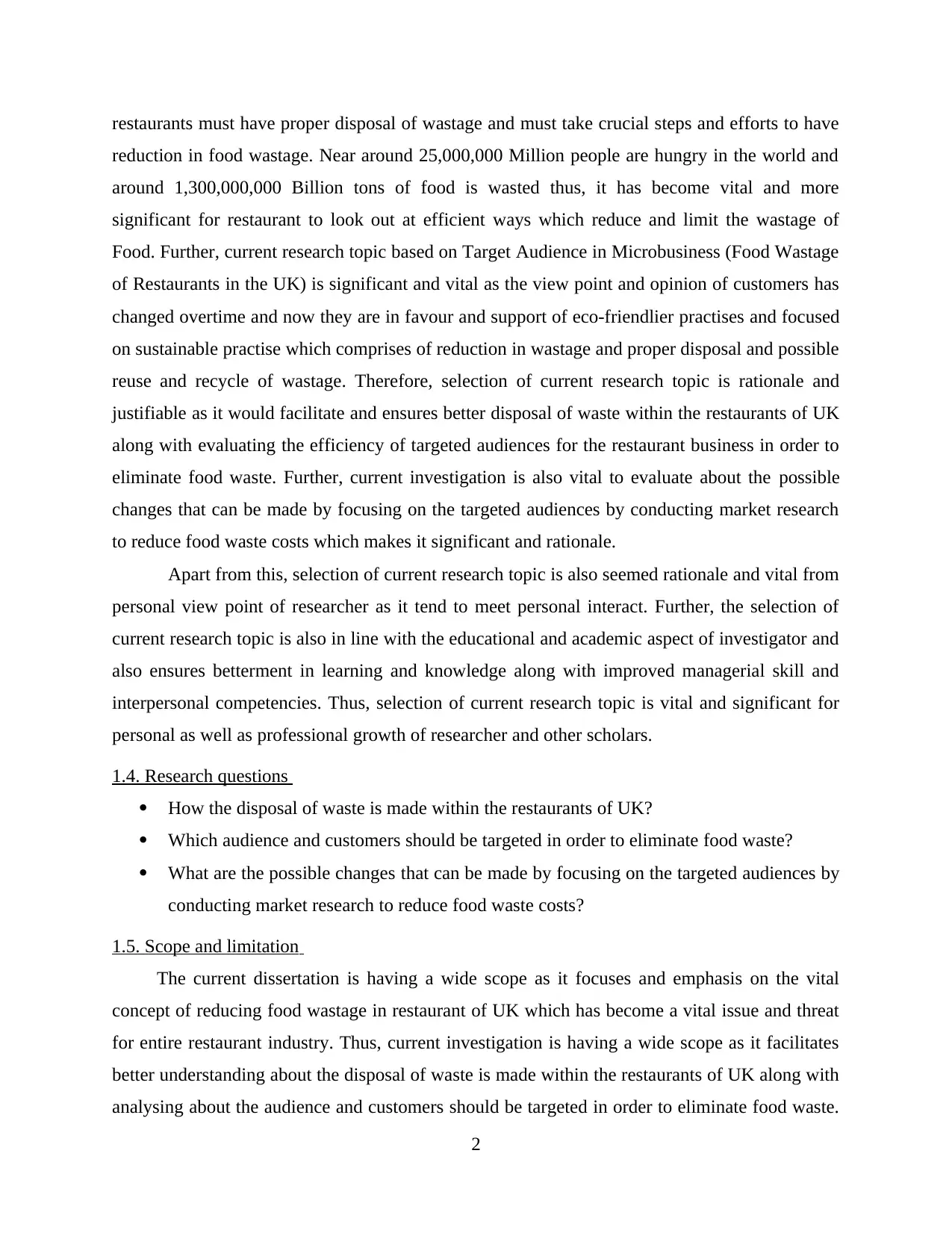
restaurants must have proper disposal of wastage and must take crucial steps and efforts to have
reduction in food wastage. Near around 25,000,000 Million people are hungry in the world and
around 1,300,000,000 Billion tons of food is wasted thus, it has become vital and more
significant for restaurant to look out at efficient ways which reduce and limit the wastage of
Food. Further, current research topic based on Target Audience in Microbusiness (Food Wastage
of Restaurants in the UK) is significant and vital as the view point and opinion of customers has
changed overtime and now they are in favour and support of eco-friendlier practises and focused
on sustainable practise which comprises of reduction in wastage and proper disposal and possible
reuse and recycle of wastage. Therefore, selection of current research topic is rationale and
justifiable as it would facilitate and ensures better disposal of waste within the restaurants of UK
along with evaluating the efficiency of targeted audiences for the restaurant business in order to
eliminate food waste. Further, current investigation is also vital to evaluate about the possible
changes that can be made by focusing on the targeted audiences by conducting market research
to reduce food waste costs which makes it significant and rationale.
Apart from this, selection of current research topic is also seemed rationale and vital from
personal view point of researcher as it tend to meet personal interact. Further, the selection of
current research topic is also in line with the educational and academic aspect of investigator and
also ensures betterment in learning and knowledge along with improved managerial skill and
interpersonal competencies. Thus, selection of current research topic is vital and significant for
personal as well as professional growth of researcher and other scholars.
1.4. Research questions
How the disposal of waste is made within the restaurants of UK?
Which audience and customers should be targeted in order to eliminate food waste?
What are the possible changes that can be made by focusing on the targeted audiences by
conducting market research to reduce food waste costs?
1.5. Scope and limitation
The current dissertation is having a wide scope as it focuses and emphasis on the vital
concept of reducing food wastage in restaurant of UK which has become a vital issue and threat
for entire restaurant industry. Thus, current investigation is having a wide scope as it facilitates
better understanding about the disposal of waste is made within the restaurants of UK along with
analysing about the audience and customers should be targeted in order to eliminate food waste.
2
reduction in food wastage. Near around 25,000,000 Million people are hungry in the world and
around 1,300,000,000 Billion tons of food is wasted thus, it has become vital and more
significant for restaurant to look out at efficient ways which reduce and limit the wastage of
Food. Further, current research topic based on Target Audience in Microbusiness (Food Wastage
of Restaurants in the UK) is significant and vital as the view point and opinion of customers has
changed overtime and now they are in favour and support of eco-friendlier practises and focused
on sustainable practise which comprises of reduction in wastage and proper disposal and possible
reuse and recycle of wastage. Therefore, selection of current research topic is rationale and
justifiable as it would facilitate and ensures better disposal of waste within the restaurants of UK
along with evaluating the efficiency of targeted audiences for the restaurant business in order to
eliminate food waste. Further, current investigation is also vital to evaluate about the possible
changes that can be made by focusing on the targeted audiences by conducting market research
to reduce food waste costs which makes it significant and rationale.
Apart from this, selection of current research topic is also seemed rationale and vital from
personal view point of researcher as it tend to meet personal interact. Further, the selection of
current research topic is also in line with the educational and academic aspect of investigator and
also ensures betterment in learning and knowledge along with improved managerial skill and
interpersonal competencies. Thus, selection of current research topic is vital and significant for
personal as well as professional growth of researcher and other scholars.
1.4. Research questions
How the disposal of waste is made within the restaurants of UK?
Which audience and customers should be targeted in order to eliminate food waste?
What are the possible changes that can be made by focusing on the targeted audiences by
conducting market research to reduce food waste costs?
1.5. Scope and limitation
The current dissertation is having a wide scope as it focuses and emphasis on the vital
concept of reducing food wastage in restaurant of UK which has become a vital issue and threat
for entire restaurant industry. Thus, current investigation is having a wide scope as it facilitates
better understanding about the disposal of waste is made within the restaurants of UK along with
analysing about the audience and customers should be targeted in order to eliminate food waste.
2
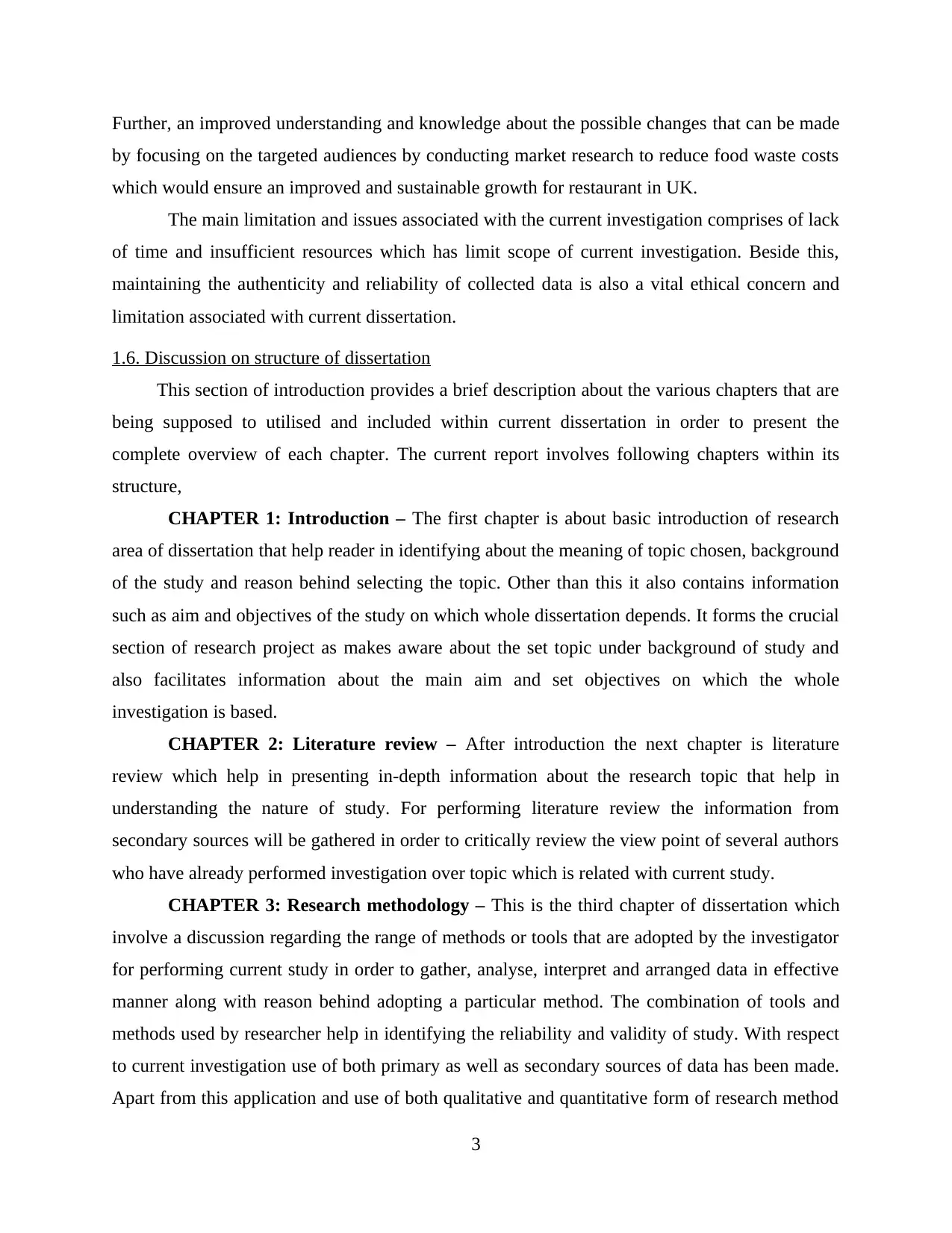
Further, an improved understanding and knowledge about the possible changes that can be made
by focusing on the targeted audiences by conducting market research to reduce food waste costs
which would ensure an improved and sustainable growth for restaurant in UK.
The main limitation and issues associated with the current investigation comprises of lack
of time and insufficient resources which has limit scope of current investigation. Beside this,
maintaining the authenticity and reliability of collected data is also a vital ethical concern and
limitation associated with current dissertation.
1.6. Discussion on structure of dissertation
This section of introduction provides a brief description about the various chapters that are
being supposed to utilised and included within current dissertation in order to present the
complete overview of each chapter. The current report involves following chapters within its
structure,
CHAPTER 1: Introduction – The first chapter is about basic introduction of research
area of dissertation that help reader in identifying about the meaning of topic chosen, background
of the study and reason behind selecting the topic. Other than this it also contains information
such as aim and objectives of the study on which whole dissertation depends. It forms the crucial
section of research project as makes aware about the set topic under background of study and
also facilitates information about the main aim and set objectives on which the whole
investigation is based.
CHAPTER 2: Literature review – After introduction the next chapter is literature
review which help in presenting in-depth information about the research topic that help in
understanding the nature of study. For performing literature review the information from
secondary sources will be gathered in order to critically review the view point of several authors
who have already performed investigation over topic which is related with current study.
CHAPTER 3: Research methodology – This is the third chapter of dissertation which
involve a discussion regarding the range of methods or tools that are adopted by the investigator
for performing current study in order to gather, analyse, interpret and arranged data in effective
manner along with reason behind adopting a particular method. The combination of tools and
methods used by researcher help in identifying the reliability and validity of study. With respect
to current investigation use of both primary as well as secondary sources of data has been made.
Apart from this application and use of both qualitative and quantitative form of research method
3
by focusing on the targeted audiences by conducting market research to reduce food waste costs
which would ensure an improved and sustainable growth for restaurant in UK.
The main limitation and issues associated with the current investigation comprises of lack
of time and insufficient resources which has limit scope of current investigation. Beside this,
maintaining the authenticity and reliability of collected data is also a vital ethical concern and
limitation associated with current dissertation.
1.6. Discussion on structure of dissertation
This section of introduction provides a brief description about the various chapters that are
being supposed to utilised and included within current dissertation in order to present the
complete overview of each chapter. The current report involves following chapters within its
structure,
CHAPTER 1: Introduction – The first chapter is about basic introduction of research
area of dissertation that help reader in identifying about the meaning of topic chosen, background
of the study and reason behind selecting the topic. Other than this it also contains information
such as aim and objectives of the study on which whole dissertation depends. It forms the crucial
section of research project as makes aware about the set topic under background of study and
also facilitates information about the main aim and set objectives on which the whole
investigation is based.
CHAPTER 2: Literature review – After introduction the next chapter is literature
review which help in presenting in-depth information about the research topic that help in
understanding the nature of study. For performing literature review the information from
secondary sources will be gathered in order to critically review the view point of several authors
who have already performed investigation over topic which is related with current study.
CHAPTER 3: Research methodology – This is the third chapter of dissertation which
involve a discussion regarding the range of methods or tools that are adopted by the investigator
for performing current study in order to gather, analyse, interpret and arranged data in effective
manner along with reason behind adopting a particular method. The combination of tools and
methods used by researcher help in identifying the reliability and validity of study. With respect
to current investigation use of both primary as well as secondary sources of data has been made.
Apart from this application and use of both qualitative and quantitative form of research method
3
Paraphrase This Document
Need a fresh take? Get an instant paraphrase of this document with our AI Paraphraser
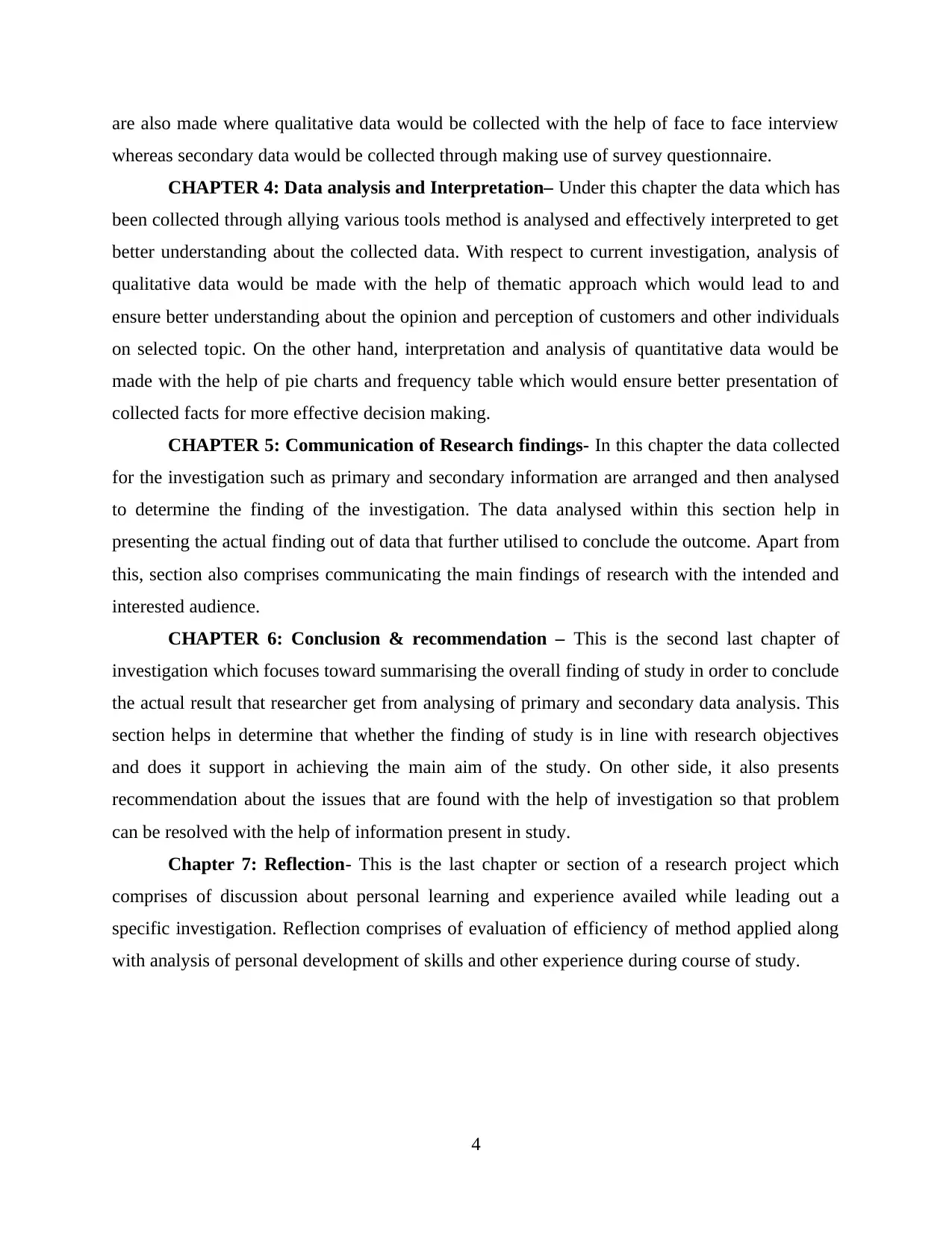
are also made where qualitative data would be collected with the help of face to face interview
whereas secondary data would be collected through making use of survey questionnaire.
CHAPTER 4: Data analysis and Interpretation– Under this chapter the data which has
been collected through allying various tools method is analysed and effectively interpreted to get
better understanding about the collected data. With respect to current investigation, analysis of
qualitative data would be made with the help of thematic approach which would lead to and
ensure better understanding about the opinion and perception of customers and other individuals
on selected topic. On the other hand, interpretation and analysis of quantitative data would be
made with the help of pie charts and frequency table which would ensure better presentation of
collected facts for more effective decision making.
CHAPTER 5: Communication of Research findings- In this chapter the data collected
for the investigation such as primary and secondary information are arranged and then analysed
to determine the finding of the investigation. The data analysed within this section help in
presenting the actual finding out of data that further utilised to conclude the outcome. Apart from
this, section also comprises communicating the main findings of research with the intended and
interested audience.
CHAPTER 6: Conclusion & recommendation – This is the second last chapter of
investigation which focuses toward summarising the overall finding of study in order to conclude
the actual result that researcher get from analysing of primary and secondary data analysis. This
section helps in determine that whether the finding of study is in line with research objectives
and does it support in achieving the main aim of the study. On other side, it also presents
recommendation about the issues that are found with the help of investigation so that problem
can be resolved with the help of information present in study.
Chapter 7: Reflection- This is the last chapter or section of a research project which
comprises of discussion about personal learning and experience availed while leading out a
specific investigation. Reflection comprises of evaluation of efficiency of method applied along
with analysis of personal development of skills and other experience during course of study.
4
whereas secondary data would be collected through making use of survey questionnaire.
CHAPTER 4: Data analysis and Interpretation– Under this chapter the data which has
been collected through allying various tools method is analysed and effectively interpreted to get
better understanding about the collected data. With respect to current investigation, analysis of
qualitative data would be made with the help of thematic approach which would lead to and
ensure better understanding about the opinion and perception of customers and other individuals
on selected topic. On the other hand, interpretation and analysis of quantitative data would be
made with the help of pie charts and frequency table which would ensure better presentation of
collected facts for more effective decision making.
CHAPTER 5: Communication of Research findings- In this chapter the data collected
for the investigation such as primary and secondary information are arranged and then analysed
to determine the finding of the investigation. The data analysed within this section help in
presenting the actual finding out of data that further utilised to conclude the outcome. Apart from
this, section also comprises communicating the main findings of research with the intended and
interested audience.
CHAPTER 6: Conclusion & recommendation – This is the second last chapter of
investigation which focuses toward summarising the overall finding of study in order to conclude
the actual result that researcher get from analysing of primary and secondary data analysis. This
section helps in determine that whether the finding of study is in line with research objectives
and does it support in achieving the main aim of the study. On other side, it also presents
recommendation about the issues that are found with the help of investigation so that problem
can be resolved with the help of information present in study.
Chapter 7: Reflection- This is the last chapter or section of a research project which
comprises of discussion about personal learning and experience availed while leading out a
specific investigation. Reflection comprises of evaluation of efficiency of method applied along
with analysis of personal development of skills and other experience during course of study.
4
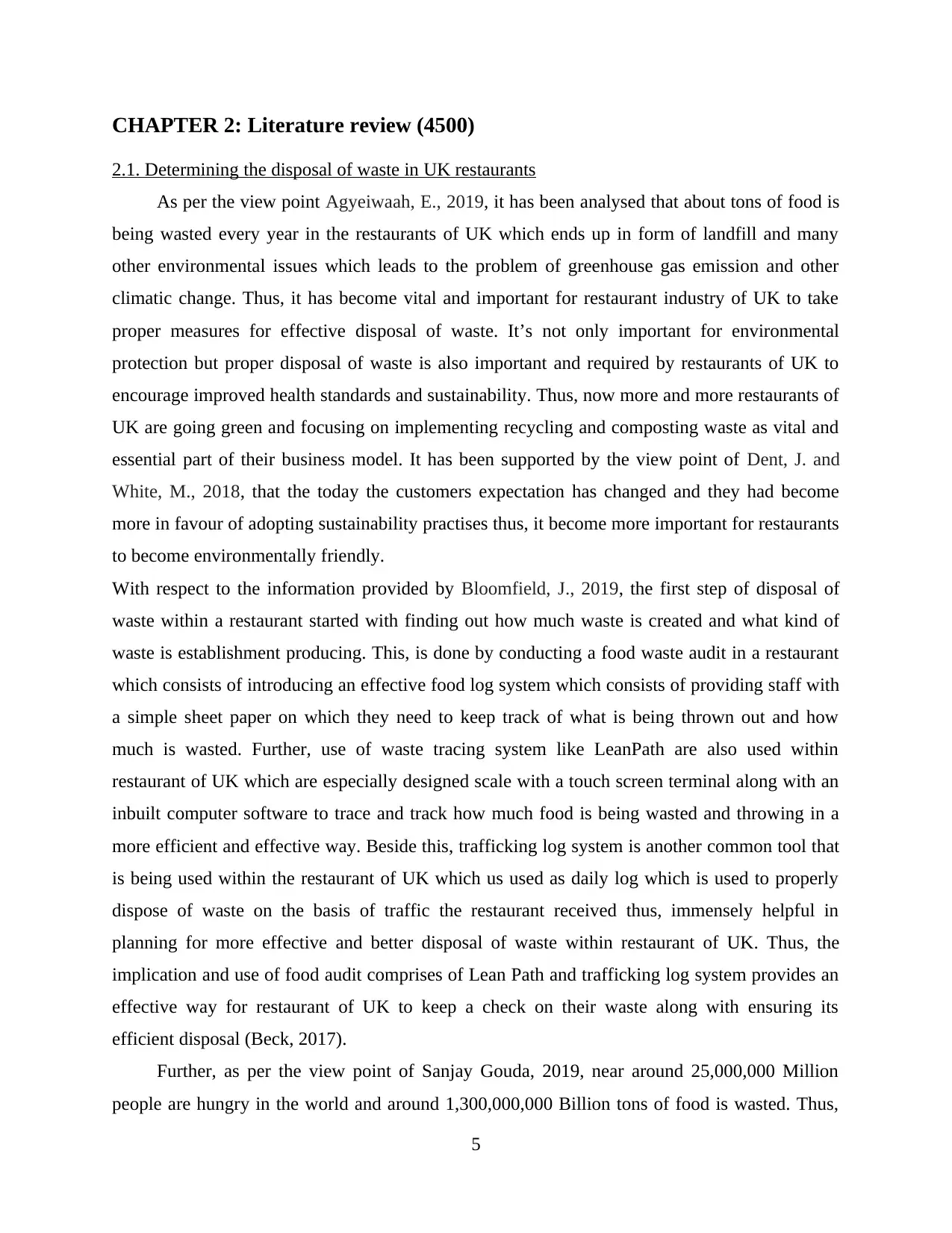
CHAPTER 2: Literature review (4500)
2.1. Determining the disposal of waste in UK restaurants
As per the view point Agyeiwaah, E., 2019, it has been analysed that about tons of food is
being wasted every year in the restaurants of UK which ends up in form of landfill and many
other environmental issues which leads to the problem of greenhouse gas emission and other
climatic change. Thus, it has become vital and important for restaurant industry of UK to take
proper measures for effective disposal of waste. It’s not only important for environmental
protection but proper disposal of waste is also important and required by restaurants of UK to
encourage improved health standards and sustainability. Thus, now more and more restaurants of
UK are going green and focusing on implementing recycling and composting waste as vital and
essential part of their business model. It has been supported by the view point of Dent, J. and
White, M., 2018, that the today the customers expectation has changed and they had become
more in favour of adopting sustainability practises thus, it become more important for restaurants
to become environmentally friendly.
With respect to the information provided by Bloomfield, J., 2019, the first step of disposal of
waste within a restaurant started with finding out how much waste is created and what kind of
waste is establishment producing. This, is done by conducting a food waste audit in a restaurant
which consists of introducing an effective food log system which consists of providing staff with
a simple sheet paper on which they need to keep track of what is being thrown out and how
much is wasted. Further, use of waste tracing system like LeanPath are also used within
restaurant of UK which are especially designed scale with a touch screen terminal along with an
inbuilt computer software to trace and track how much food is being wasted and throwing in a
more efficient and effective way. Beside this, trafficking log system is another common tool that
is being used within the restaurant of UK which us used as daily log which is used to properly
dispose of waste on the basis of traffic the restaurant received thus, immensely helpful in
planning for more effective and better disposal of waste within restaurant of UK. Thus, the
implication and use of food audit comprises of Lean Path and trafficking log system provides an
effective way for restaurant of UK to keep a check on their waste along with ensuring its
efficient disposal (Beck, 2017).
Further, as per the view point of Sanjay Gouda, 2019, near around 25,000,000 Million
people are hungry in the world and around 1,300,000,000 Billion tons of food is wasted. Thus,
5
2.1. Determining the disposal of waste in UK restaurants
As per the view point Agyeiwaah, E., 2019, it has been analysed that about tons of food is
being wasted every year in the restaurants of UK which ends up in form of landfill and many
other environmental issues which leads to the problem of greenhouse gas emission and other
climatic change. Thus, it has become vital and important for restaurant industry of UK to take
proper measures for effective disposal of waste. It’s not only important for environmental
protection but proper disposal of waste is also important and required by restaurants of UK to
encourage improved health standards and sustainability. Thus, now more and more restaurants of
UK are going green and focusing on implementing recycling and composting waste as vital and
essential part of their business model. It has been supported by the view point of Dent, J. and
White, M., 2018, that the today the customers expectation has changed and they had become
more in favour of adopting sustainability practises thus, it become more important for restaurants
to become environmentally friendly.
With respect to the information provided by Bloomfield, J., 2019, the first step of disposal of
waste within a restaurant started with finding out how much waste is created and what kind of
waste is establishment producing. This, is done by conducting a food waste audit in a restaurant
which consists of introducing an effective food log system which consists of providing staff with
a simple sheet paper on which they need to keep track of what is being thrown out and how
much is wasted. Further, use of waste tracing system like LeanPath are also used within
restaurant of UK which are especially designed scale with a touch screen terminal along with an
inbuilt computer software to trace and track how much food is being wasted and throwing in a
more efficient and effective way. Beside this, trafficking log system is another common tool that
is being used within the restaurant of UK which us used as daily log which is used to properly
dispose of waste on the basis of traffic the restaurant received thus, immensely helpful in
planning for more effective and better disposal of waste within restaurant of UK. Thus, the
implication and use of food audit comprises of Lean Path and trafficking log system provides an
effective way for restaurant of UK to keep a check on their waste along with ensuring its
efficient disposal (Beck, 2017).
Further, as per the view point of Sanjay Gouda, 2019, near around 25,000,000 Million
people are hungry in the world and around 1,300,000,000 Billion tons of food is wasted. Thus,
5
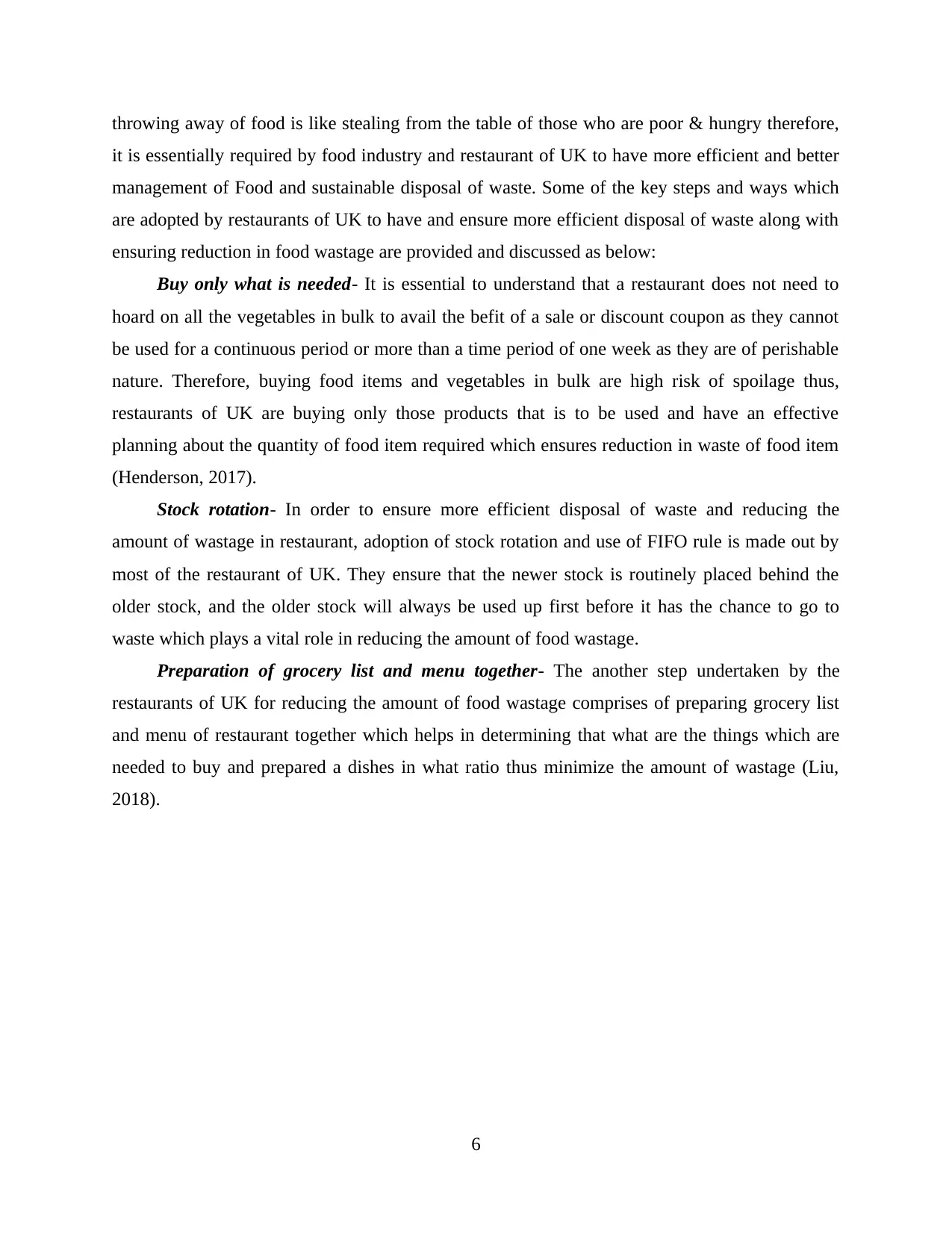
throwing away of food is like stealing from the table of those who are poor & hungry therefore,
it is essentially required by food industry and restaurant of UK to have more efficient and better
management of Food and sustainable disposal of waste. Some of the key steps and ways which
are adopted by restaurants of UK to have and ensure more efficient disposal of waste along with
ensuring reduction in food wastage are provided and discussed as below:
Buy only what is needed- It is essential to understand that a restaurant does not need to
hoard on all the vegetables in bulk to avail the befit of a sale or discount coupon as they cannot
be used for a continuous period or more than a time period of one week as they are of perishable
nature. Therefore, buying food items and vegetables in bulk are high risk of spoilage thus,
restaurants of UK are buying only those products that is to be used and have an effective
planning about the quantity of food item required which ensures reduction in waste of food item
(Henderson, 2017).
Stock rotation- In order to ensure more efficient disposal of waste and reducing the
amount of wastage in restaurant, adoption of stock rotation and use of FIFO rule is made out by
most of the restaurant of UK. They ensure that the newer stock is routinely placed behind the
older stock, and the older stock will always be used up first before it has the chance to go to
waste which plays a vital role in reducing the amount of food wastage.
Preparation of grocery list and menu together- The another step undertaken by the
restaurants of UK for reducing the amount of food wastage comprises of preparing grocery list
and menu of restaurant together which helps in determining that what are the things which are
needed to buy and prepared a dishes in what ratio thus minimize the amount of wastage (Liu,
2018).
6
it is essentially required by food industry and restaurant of UK to have more efficient and better
management of Food and sustainable disposal of waste. Some of the key steps and ways which
are adopted by restaurants of UK to have and ensure more efficient disposal of waste along with
ensuring reduction in food wastage are provided and discussed as below:
Buy only what is needed- It is essential to understand that a restaurant does not need to
hoard on all the vegetables in bulk to avail the befit of a sale or discount coupon as they cannot
be used for a continuous period or more than a time period of one week as they are of perishable
nature. Therefore, buying food items and vegetables in bulk are high risk of spoilage thus,
restaurants of UK are buying only those products that is to be used and have an effective
planning about the quantity of food item required which ensures reduction in waste of food item
(Henderson, 2017).
Stock rotation- In order to ensure more efficient disposal of waste and reducing the
amount of wastage in restaurant, adoption of stock rotation and use of FIFO rule is made out by
most of the restaurant of UK. They ensure that the newer stock is routinely placed behind the
older stock, and the older stock will always be used up first before it has the chance to go to
waste which plays a vital role in reducing the amount of food wastage.
Preparation of grocery list and menu together- The another step undertaken by the
restaurants of UK for reducing the amount of food wastage comprises of preparing grocery list
and menu of restaurant together which helps in determining that what are the things which are
needed to buy and prepared a dishes in what ratio thus minimize the amount of wastage (Liu,
2018).
6
Secure Best Marks with AI Grader
Need help grading? Try our AI Grader for instant feedback on your assignments.
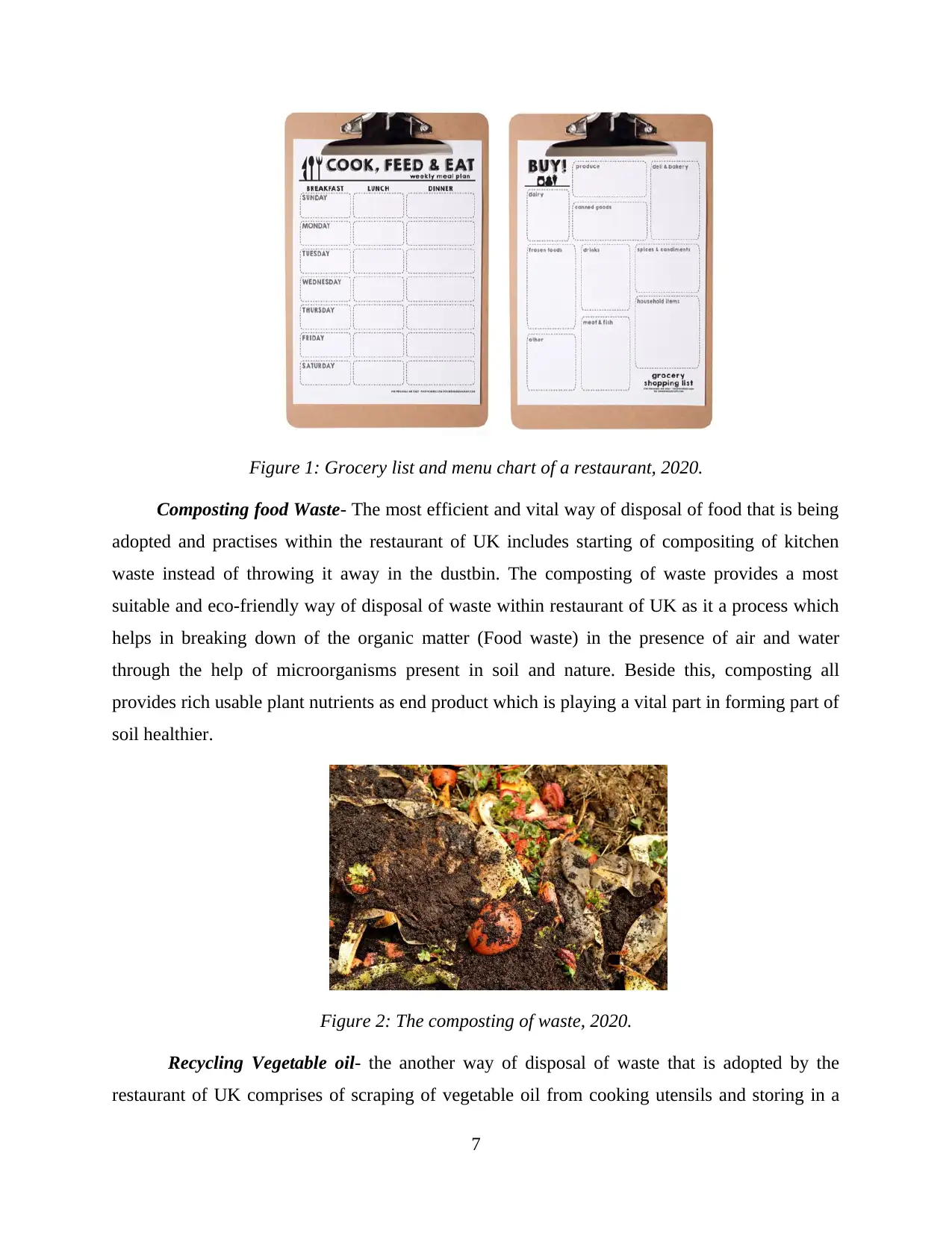
Figure 1: Grocery list and menu chart of a restaurant, 2020.
Composting food Waste- The most efficient and vital way of disposal of food that is being
adopted and practises within the restaurant of UK includes starting of compositing of kitchen
waste instead of throwing it away in the dustbin. The composting of waste provides a most
suitable and eco-friendly way of disposal of waste within restaurant of UK as it a process which
helps in breaking down of the organic matter (Food waste) in the presence of air and water
through the help of microorganisms present in soil and nature. Beside this, composting all
provides rich usable plant nutrients as end product which is playing a vital part in forming part of
soil healthier.
Figure 2: The composting of waste, 2020.
Recycling Vegetable oil- the another way of disposal of waste that is adopted by the
restaurant of UK comprises of scraping of vegetable oil from cooking utensils and storing in a
7
Composting food Waste- The most efficient and vital way of disposal of food that is being
adopted and practises within the restaurant of UK includes starting of compositing of kitchen
waste instead of throwing it away in the dustbin. The composting of waste provides a most
suitable and eco-friendly way of disposal of waste within restaurant of UK as it a process which
helps in breaking down of the organic matter (Food waste) in the presence of air and water
through the help of microorganisms present in soil and nature. Beside this, composting all
provides rich usable plant nutrients as end product which is playing a vital part in forming part of
soil healthier.
Figure 2: The composting of waste, 2020.
Recycling Vegetable oil- the another way of disposal of waste that is adopted by the
restaurant of UK comprises of scraping of vegetable oil from cooking utensils and storing in a
7
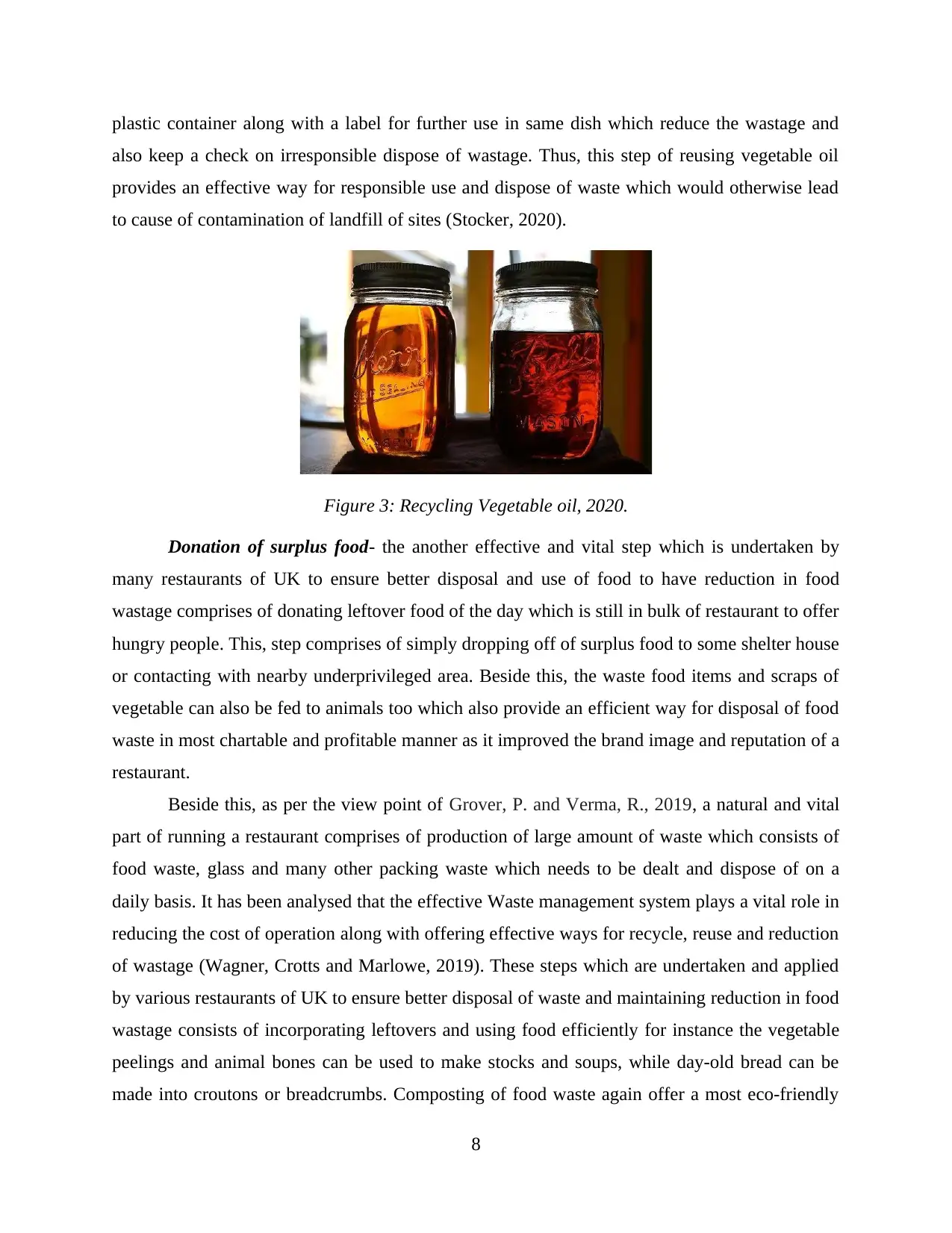
plastic container along with a label for further use in same dish which reduce the wastage and
also keep a check on irresponsible dispose of wastage. Thus, this step of reusing vegetable oil
provides an effective way for responsible use and dispose of waste which would otherwise lead
to cause of contamination of landfill of sites (Stocker, 2020).
Figure 3: Recycling Vegetable oil, 2020.
Donation of surplus food- the another effective and vital step which is undertaken by
many restaurants of UK to ensure better disposal and use of food to have reduction in food
wastage comprises of donating leftover food of the day which is still in bulk of restaurant to offer
hungry people. This, step comprises of simply dropping off of surplus food to some shelter house
or contacting with nearby underprivileged area. Beside this, the waste food items and scraps of
vegetable can also be fed to animals too which also provide an efficient way for disposal of food
waste in most chartable and profitable manner as it improved the brand image and reputation of a
restaurant.
Beside this, as per the view point of Grover, P. and Verma, R., 2019, a natural and vital
part of running a restaurant comprises of production of large amount of waste which consists of
food waste, glass and many other packing waste which needs to be dealt and dispose of on a
daily basis. It has been analysed that the effective Waste management system plays a vital role in
reducing the cost of operation along with offering effective ways for recycle, reuse and reduction
of wastage (Wagner, Crotts and Marlowe, 2019). These steps which are undertaken and applied
by various restaurants of UK to ensure better disposal of waste and maintaining reduction in food
wastage consists of incorporating leftovers and using food efficiently for instance the vegetable
peelings and animal bones can be used to make stocks and soups, while day-old bread can be
made into croutons or breadcrumbs. Composting of food waste again offer a most eco-friendly
8
also keep a check on irresponsible dispose of wastage. Thus, this step of reusing vegetable oil
provides an effective way for responsible use and dispose of waste which would otherwise lead
to cause of contamination of landfill of sites (Stocker, 2020).
Figure 3: Recycling Vegetable oil, 2020.
Donation of surplus food- the another effective and vital step which is undertaken by
many restaurants of UK to ensure better disposal and use of food to have reduction in food
wastage comprises of donating leftover food of the day which is still in bulk of restaurant to offer
hungry people. This, step comprises of simply dropping off of surplus food to some shelter house
or contacting with nearby underprivileged area. Beside this, the waste food items and scraps of
vegetable can also be fed to animals too which also provide an efficient way for disposal of food
waste in most chartable and profitable manner as it improved the brand image and reputation of a
restaurant.
Beside this, as per the view point of Grover, P. and Verma, R., 2019, a natural and vital
part of running a restaurant comprises of production of large amount of waste which consists of
food waste, glass and many other packing waste which needs to be dealt and dispose of on a
daily basis. It has been analysed that the effective Waste management system plays a vital role in
reducing the cost of operation along with offering effective ways for recycle, reuse and reduction
of wastage (Wagner, Crotts and Marlowe, 2019). These steps which are undertaken and applied
by various restaurants of UK to ensure better disposal of waste and maintaining reduction in food
wastage consists of incorporating leftovers and using food efficiently for instance the vegetable
peelings and animal bones can be used to make stocks and soups, while day-old bread can be
made into croutons or breadcrumbs. Composting of food waste again offer a most eco-friendly
8
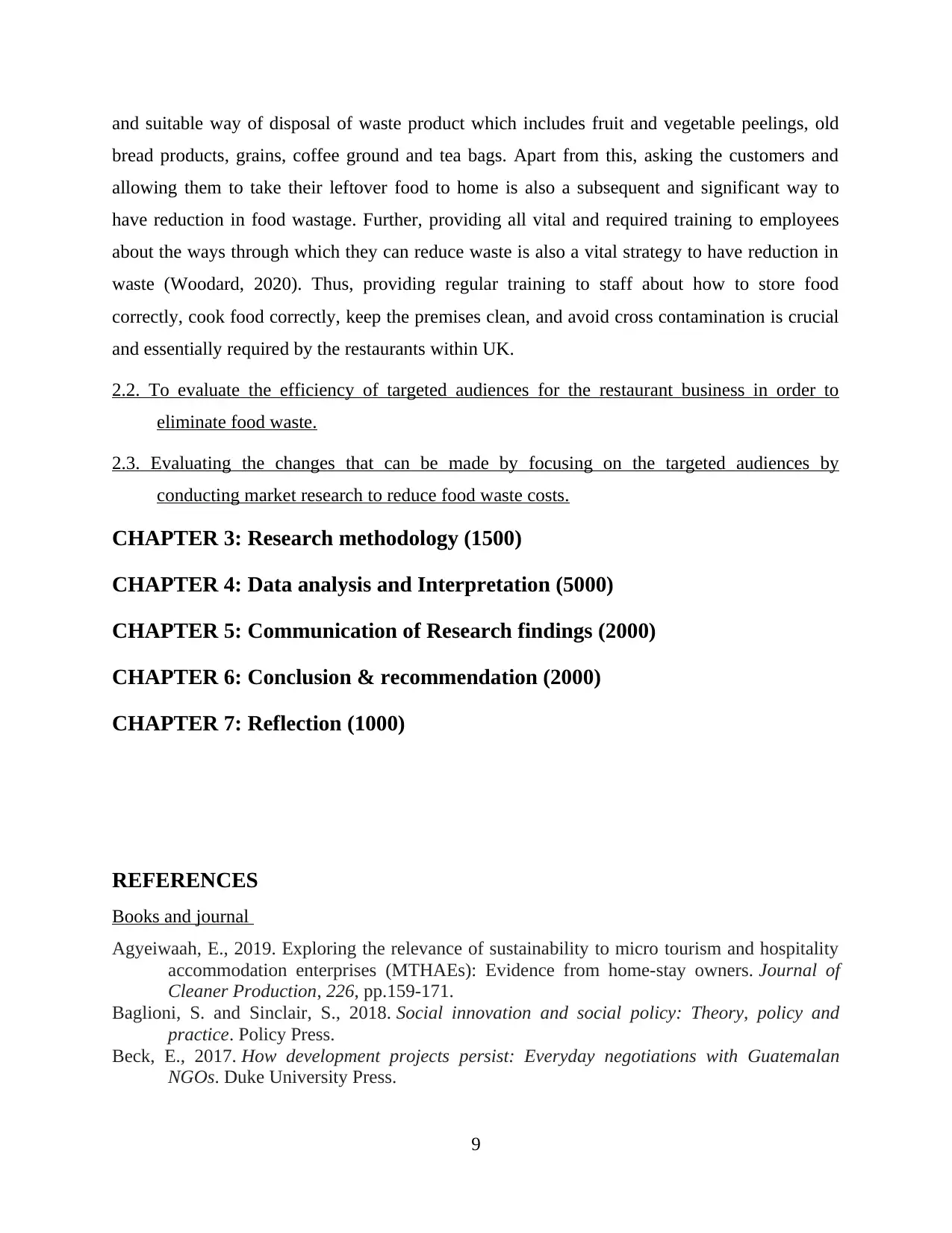
and suitable way of disposal of waste product which includes fruit and vegetable peelings, old
bread products, grains, coffee ground and tea bags. Apart from this, asking the customers and
allowing them to take their leftover food to home is also a subsequent and significant way to
have reduction in food wastage. Further, providing all vital and required training to employees
about the ways through which they can reduce waste is also a vital strategy to have reduction in
waste (Woodard, 2020). Thus, providing regular training to staff about how to store food
correctly, cook food correctly, keep the premises clean, and avoid cross contamination is crucial
and essentially required by the restaurants within UK.
2.2. To evaluate the efficiency of targeted audiences for the restaurant business in order to
eliminate food waste.
2.3. Evaluating the changes that can be made by focusing on the targeted audiences by
conducting market research to reduce food waste costs.
CHAPTER 3: Research methodology (1500)
CHAPTER 4: Data analysis and Interpretation (5000)
CHAPTER 5: Communication of Research findings (2000)
CHAPTER 6: Conclusion & recommendation (2000)
CHAPTER 7: Reflection (1000)
REFERENCES
Books and journal
Agyeiwaah, E., 2019. Exploring the relevance of sustainability to micro tourism and hospitality
accommodation enterprises (MTHAEs): Evidence from home-stay owners. Journal of
Cleaner Production, 226, pp.159-171.
Baglioni, S. and Sinclair, S., 2018. Social innovation and social policy: Theory, policy and
practice. Policy Press.
Beck, E., 2017. How development projects persist: Everyday negotiations with Guatemalan
NGOs. Duke University Press.
9
bread products, grains, coffee ground and tea bags. Apart from this, asking the customers and
allowing them to take their leftover food to home is also a subsequent and significant way to
have reduction in food wastage. Further, providing all vital and required training to employees
about the ways through which they can reduce waste is also a vital strategy to have reduction in
waste (Woodard, 2020). Thus, providing regular training to staff about how to store food
correctly, cook food correctly, keep the premises clean, and avoid cross contamination is crucial
and essentially required by the restaurants within UK.
2.2. To evaluate the efficiency of targeted audiences for the restaurant business in order to
eliminate food waste.
2.3. Evaluating the changes that can be made by focusing on the targeted audiences by
conducting market research to reduce food waste costs.
CHAPTER 3: Research methodology (1500)
CHAPTER 4: Data analysis and Interpretation (5000)
CHAPTER 5: Communication of Research findings (2000)
CHAPTER 6: Conclusion & recommendation (2000)
CHAPTER 7: Reflection (1000)
REFERENCES
Books and journal
Agyeiwaah, E., 2019. Exploring the relevance of sustainability to micro tourism and hospitality
accommodation enterprises (MTHAEs): Evidence from home-stay owners. Journal of
Cleaner Production, 226, pp.159-171.
Baglioni, S. and Sinclair, S., 2018. Social innovation and social policy: Theory, policy and
practice. Policy Press.
Beck, E., 2017. How development projects persist: Everyday negotiations with Guatemalan
NGOs. Duke University Press.
9
Paraphrase This Document
Need a fresh take? Get an instant paraphrase of this document with our AI Paraphraser
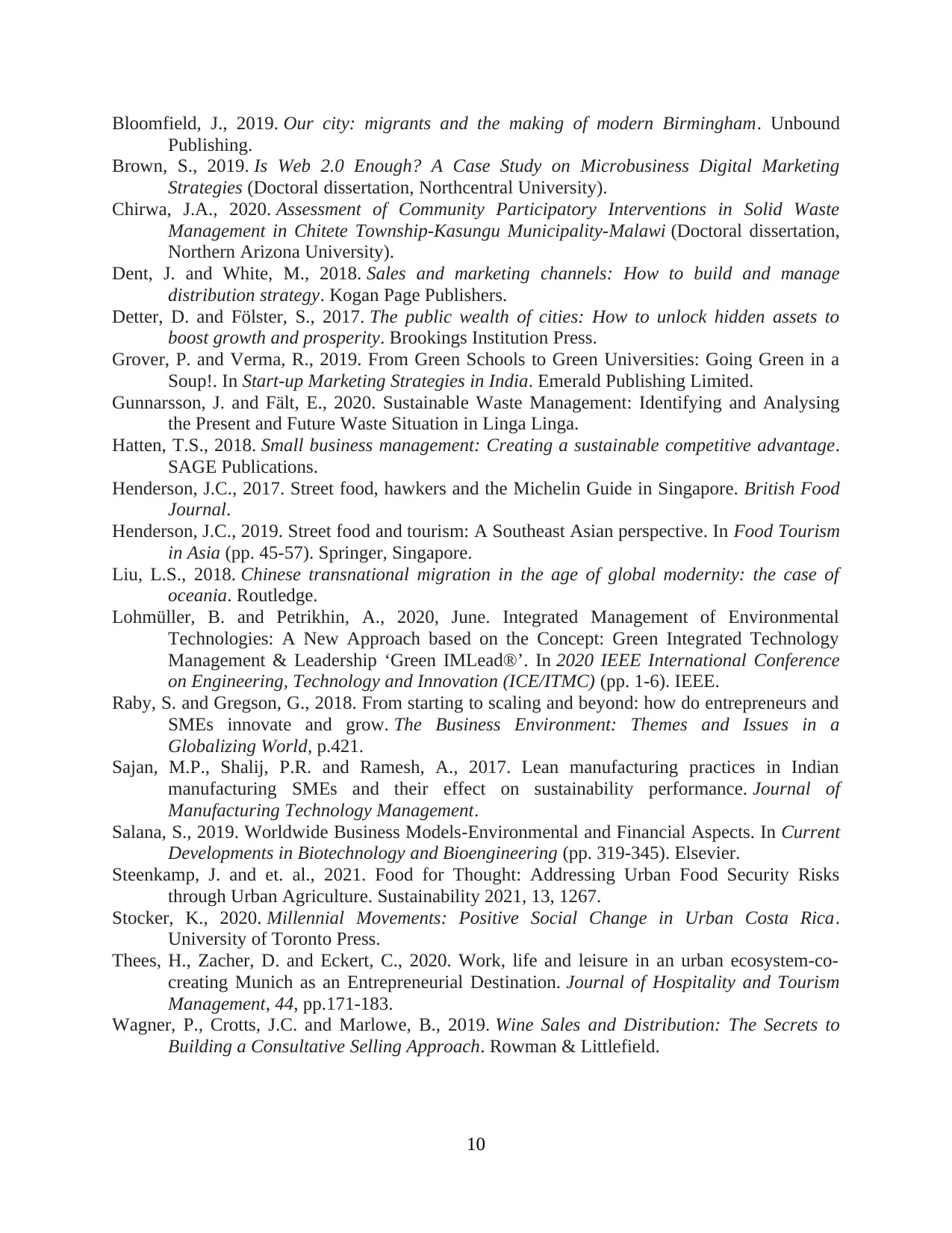
Bloomfield, J., 2019. Our city: migrants and the making of modern Birmingham. Unbound
Publishing.
Brown, S., 2019. Is Web 2.0 Enough? A Case Study on Microbusiness Digital Marketing
Strategies (Doctoral dissertation, Northcentral University).
Chirwa, J.A., 2020. Assessment of Community Participatory Interventions in Solid Waste
Management in Chitete Township-Kasungu Municipality-Malawi (Doctoral dissertation,
Northern Arizona University).
Dent, J. and White, M., 2018. Sales and marketing channels: How to build and manage
distribution strategy. Kogan Page Publishers.
Detter, D. and Fölster, S., 2017. The public wealth of cities: How to unlock hidden assets to
boost growth and prosperity. Brookings Institution Press.
Grover, P. and Verma, R., 2019. From Green Schools to Green Universities: Going Green in a
Soup!. In Start-up Marketing Strategies in India. Emerald Publishing Limited.
Gunnarsson, J. and Fält, E., 2020. Sustainable Waste Management: Identifying and Analysing
the Present and Future Waste Situation in Linga Linga.
Hatten, T.S., 2018. Small business management: Creating a sustainable competitive advantage.
SAGE Publications.
Henderson, J.C., 2017. Street food, hawkers and the Michelin Guide in Singapore. British Food
Journal.
Henderson, J.C., 2019. Street food and tourism: A Southeast Asian perspective. In Food Tourism
in Asia (pp. 45-57). Springer, Singapore.
Liu, L.S., 2018. Chinese transnational migration in the age of global modernity: the case of
oceania. Routledge.
Lohmüller, B. and Petrikhin, A., 2020, June. Integrated Management of Environmental
Technologies: A New Approach based on the Concept: Green Integrated Technology
Management & Leadership ‘Green IMLead®’. In 2020 IEEE International Conference
on Engineering, Technology and Innovation (ICE/ITMC) (pp. 1-6). IEEE.
Raby, S. and Gregson, G., 2018. From starting to scaling and beyond: how do entrepreneurs and
SMEs innovate and grow. The Business Environment: Themes and Issues in a
Globalizing World, p.421.
Sajan, M.P., Shalij, P.R. and Ramesh, A., 2017. Lean manufacturing practices in Indian
manufacturing SMEs and their effect on sustainability performance. Journal of
Manufacturing Technology Management.
Salana, S., 2019. Worldwide Business Models-Environmental and Financial Aspects. In Current
Developments in Biotechnology and Bioengineering (pp. 319-345). Elsevier.
Steenkamp, J. and et. al., 2021. Food for Thought: Addressing Urban Food Security Risks
through Urban Agriculture. Sustainability 2021, 13, 1267.
Stocker, K., 2020. Millennial Movements: Positive Social Change in Urban Costa Rica.
University of Toronto Press.
Thees, H., Zacher, D. and Eckert, C., 2020. Work, life and leisure in an urban ecosystem-co-
creating Munich as an Entrepreneurial Destination. Journal of Hospitality and Tourism
Management, 44, pp.171-183.
Wagner, P., Crotts, J.C. and Marlowe, B., 2019. Wine Sales and Distribution: The Secrets to
Building a Consultative Selling Approach. Rowman & Littlefield.
10
Publishing.
Brown, S., 2019. Is Web 2.0 Enough? A Case Study on Microbusiness Digital Marketing
Strategies (Doctoral dissertation, Northcentral University).
Chirwa, J.A., 2020. Assessment of Community Participatory Interventions in Solid Waste
Management in Chitete Township-Kasungu Municipality-Malawi (Doctoral dissertation,
Northern Arizona University).
Dent, J. and White, M., 2018. Sales and marketing channels: How to build and manage
distribution strategy. Kogan Page Publishers.
Detter, D. and Fölster, S., 2017. The public wealth of cities: How to unlock hidden assets to
boost growth and prosperity. Brookings Institution Press.
Grover, P. and Verma, R., 2019. From Green Schools to Green Universities: Going Green in a
Soup!. In Start-up Marketing Strategies in India. Emerald Publishing Limited.
Gunnarsson, J. and Fält, E., 2020. Sustainable Waste Management: Identifying and Analysing
the Present and Future Waste Situation in Linga Linga.
Hatten, T.S., 2018. Small business management: Creating a sustainable competitive advantage.
SAGE Publications.
Henderson, J.C., 2017. Street food, hawkers and the Michelin Guide in Singapore. British Food
Journal.
Henderson, J.C., 2019. Street food and tourism: A Southeast Asian perspective. In Food Tourism
in Asia (pp. 45-57). Springer, Singapore.
Liu, L.S., 2018. Chinese transnational migration in the age of global modernity: the case of
oceania. Routledge.
Lohmüller, B. and Petrikhin, A., 2020, June. Integrated Management of Environmental
Technologies: A New Approach based on the Concept: Green Integrated Technology
Management & Leadership ‘Green IMLead®’. In 2020 IEEE International Conference
on Engineering, Technology and Innovation (ICE/ITMC) (pp. 1-6). IEEE.
Raby, S. and Gregson, G., 2018. From starting to scaling and beyond: how do entrepreneurs and
SMEs innovate and grow. The Business Environment: Themes and Issues in a
Globalizing World, p.421.
Sajan, M.P., Shalij, P.R. and Ramesh, A., 2017. Lean manufacturing practices in Indian
manufacturing SMEs and their effect on sustainability performance. Journal of
Manufacturing Technology Management.
Salana, S., 2019. Worldwide Business Models-Environmental and Financial Aspects. In Current
Developments in Biotechnology and Bioengineering (pp. 319-345). Elsevier.
Steenkamp, J. and et. al., 2021. Food for Thought: Addressing Urban Food Security Risks
through Urban Agriculture. Sustainability 2021, 13, 1267.
Stocker, K., 2020. Millennial Movements: Positive Social Change in Urban Costa Rica.
University of Toronto Press.
Thees, H., Zacher, D. and Eckert, C., 2020. Work, life and leisure in an urban ecosystem-co-
creating Munich as an Entrepreneurial Destination. Journal of Hospitality and Tourism
Management, 44, pp.171-183.
Wagner, P., Crotts, J.C. and Marlowe, B., 2019. Wine Sales and Distribution: The Secrets to
Building a Consultative Selling Approach. Rowman & Littlefield.
10
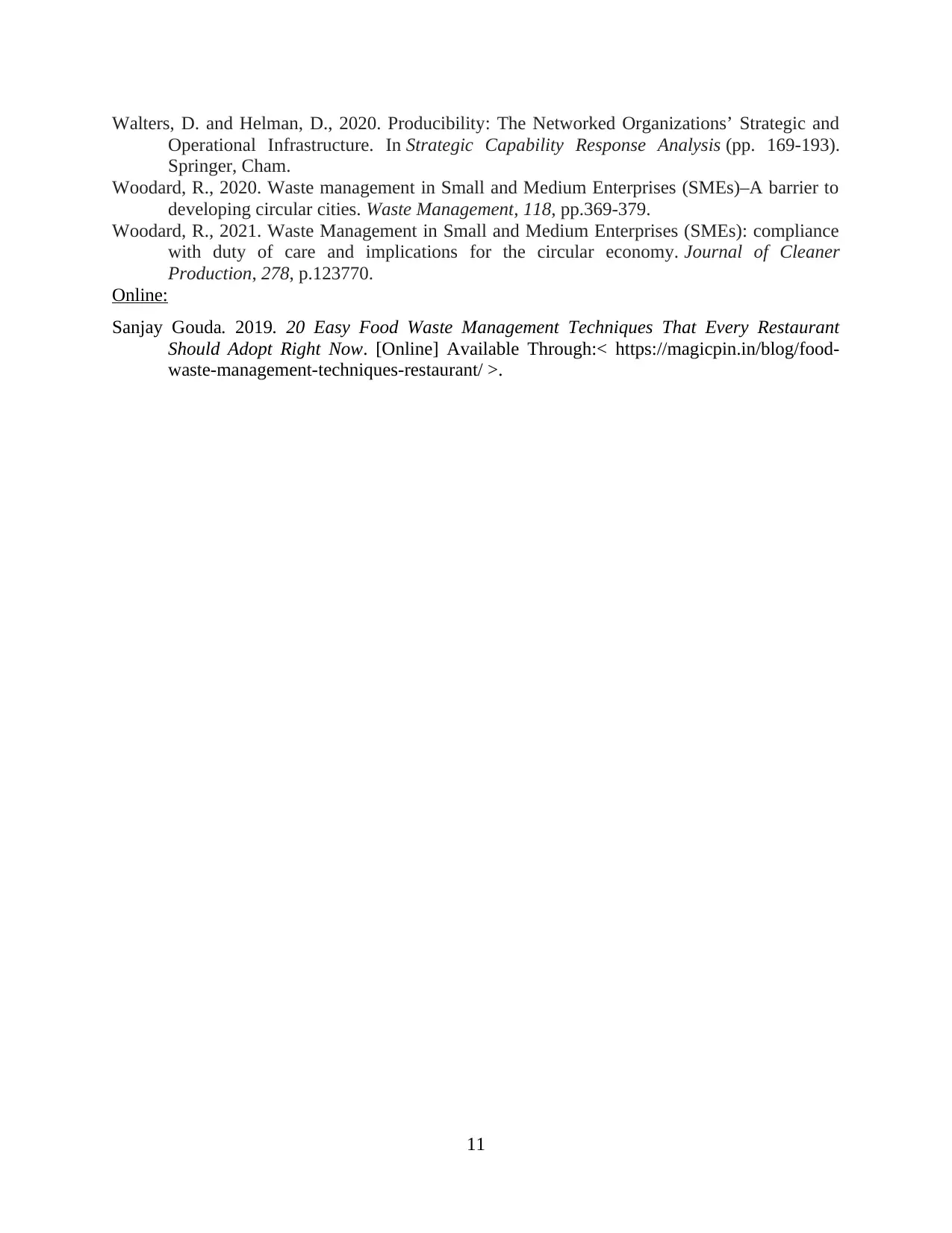
Walters, D. and Helman, D., 2020. Producibility: The Networked Organizations’ Strategic and
Operational Infrastructure. In Strategic Capability Response Analysis (pp. 169-193).
Springer, Cham.
Woodard, R., 2020. Waste management in Small and Medium Enterprises (SMEs)–A barrier to
developing circular cities. Waste Management, 118, pp.369-379.
Woodard, R., 2021. Waste Management in Small and Medium Enterprises (SMEs): compliance
with duty of care and implications for the circular economy. Journal of Cleaner
Production, 278, p.123770.
Online:
Sanjay Gouda. 2019. 20 Easy Food Waste Management Techniques That Every Restaurant
Should Adopt Right Now. [Online] Available Through:< https://magicpin.in/blog/food-
waste-management-techniques-restaurant/ >.
11
Operational Infrastructure. In Strategic Capability Response Analysis (pp. 169-193).
Springer, Cham.
Woodard, R., 2020. Waste management in Small and Medium Enterprises (SMEs)–A barrier to
developing circular cities. Waste Management, 118, pp.369-379.
Woodard, R., 2021. Waste Management in Small and Medium Enterprises (SMEs): compliance
with duty of care and implications for the circular economy. Journal of Cleaner
Production, 278, p.123770.
Online:
Sanjay Gouda. 2019. 20 Easy Food Waste Management Techniques That Every Restaurant
Should Adopt Right Now. [Online] Available Through:< https://magicpin.in/blog/food-
waste-management-techniques-restaurant/ >.
11
1 out of 15
Your All-in-One AI-Powered Toolkit for Academic Success.
+13062052269
info@desklib.com
Available 24*7 on WhatsApp / Email
![[object Object]](/_next/static/media/star-bottom.7253800d.svg)
Unlock your academic potential
© 2024 | Zucol Services PVT LTD | All rights reserved.





